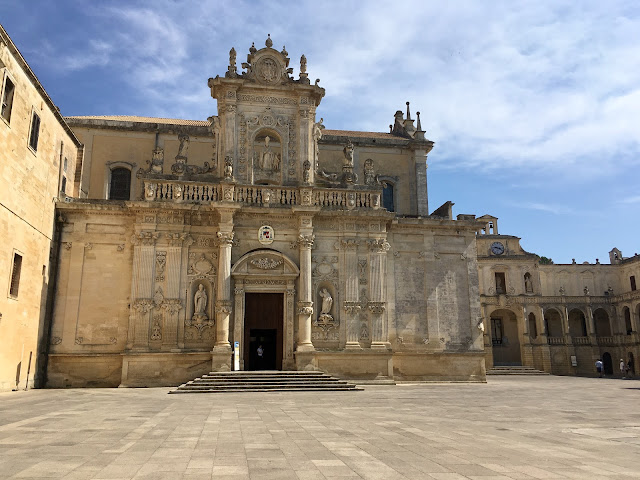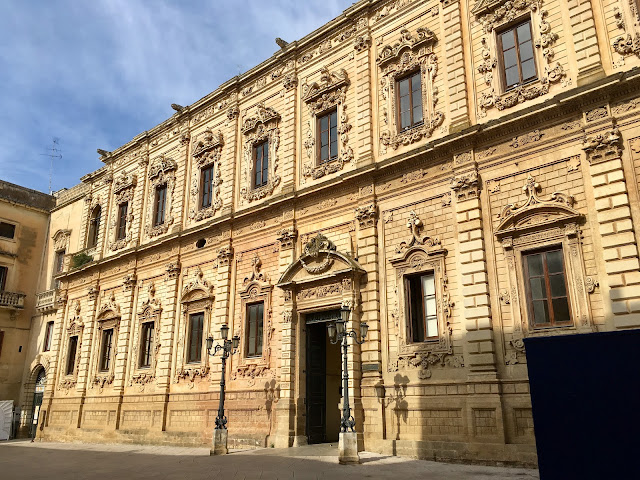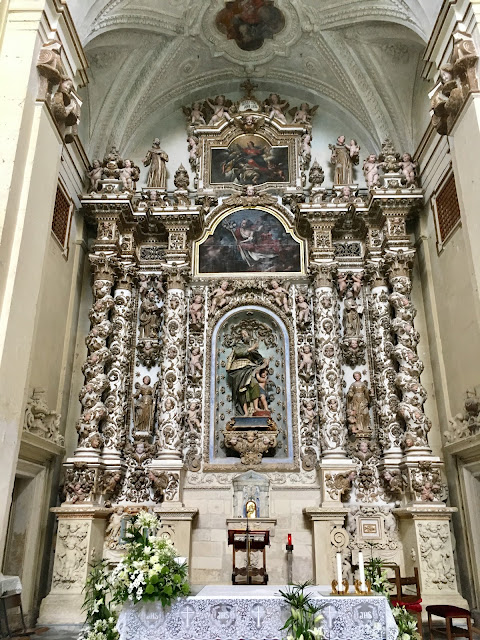We took Cosimo’s advice again today, and drove south to Otranto after breakfast. It was an hour and 40 minute drive, to Otranto, the easternmost point in Italy. It has been a flourishing port since Ancient Greek times, with the Romans, Byzantines, and Normans ruling in succession. By the 11th century, it was one of the leading Crusader ports. Otranto has grown but the historic city center is mostly intact, nestled within the old city walls, dominated by the Castello, built by Ferdinand of Aragon in the 15th century. The jewel of Otranto is Cathedral de Santa Maria Annunziata, begun by the Normans in 1080, and added to and embellished over the years. It’s original mosaic floor is entirely preserved, with scenes from the scriptures and depictions of animals and mythological subjects. The Cathedral also has a nice crypt, with a few frescoes remaining. Otranto has a protected harbor, with ferry transport to Greece.
We left Otranto just after noon, and drove back north about a half hour to Lecce. The old historic city center of Lecce is an architectural gem, filled with magnificently decorated, baroque (mostly late 16th and early 17th century) buildings. We had lunch then bought a ticket to visit five churches. Each one was more ornate than the last! Piazza Duomo is surrounded by the Seminario Diocesano, the campanile bell tower, and the Cathedral di Santa Maria Assuntia, with its crypt. The Cathedral was built between 1549 and 1646 and is considered the highest exhibition of Lecce Baroque for its decorative richness. We also visited Chiesa di Santa Chiara, Chiesa di San Matteo, and Basilica di Santa Croce. We also saw the Roman amphitheater that probably seated about 25,000 people, and the 12th century Lecce Castle built by Charles V. Lecce is a busy thriving town, but not many tourists visit. We felt as if we had the whole of magnificent Lecce to ourselves!
We left Otranto just after noon, and drove back north about a half hour to Lecce. The old historic city center of Lecce is an architectural gem, filled with magnificently decorated, baroque (mostly late 16th and early 17th century) buildings. We had lunch then bought a ticket to visit five churches. Each one was more ornate than the last! Piazza Duomo is surrounded by the Seminario Diocesano, the campanile bell tower, and the Cathedral di Santa Maria Assuntia, with its crypt. The Cathedral was built between 1549 and 1646 and is considered the highest exhibition of Lecce Baroque for its decorative richness. We also visited Chiesa di Santa Chiara, Chiesa di San Matteo, and Basilica di Santa Croce. We also saw the Roman amphitheater that probably seated about 25,000 people, and the 12th century Lecce Castle built by Charles V. Lecce is a busy thriving town, but not many tourists visit. We felt as if we had the whole of magnificent Lecce to ourselves!
























